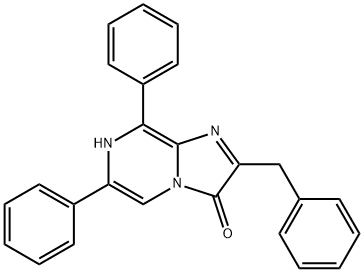All AbMole products are for research use only, cannot be used for human consumption.

Diphenylterazine is a bioluminescence agent. Diphenylterazine alone yields very little background, leading to excellent signal-to-background ratios.
To make a stock solution for Diphenylterazine, a premixture is prepared by dissolving 17.6 mg of L-ascorbic acid in 10 mL ethanol and 10 mL 1,2-propanediol firstly; next, 1 mg of Diphenylterazine is dissolved in 88 µL of the premix, resulting in a 30 mM DTZ stock solution containing 5 mM L-ascorbic acid.
Diphenylterazine (0.3 μmol/mouse [1.13 mg/ml; 100 ul/mouse]; i.v.) treatment can track tumor growth in a xenograft NU/J mouse model.
DMSO can inactivate Diphenylterazine's activity
| Molecular Weight | 377.44 |
| Formula | C25H19N3O |
| CAS Number | 344940-63-2 |
| Solubility (25°C) | DMF 10 mg/mL |
| Storage | -20°C, protect from light, sealed |
| Related Fluorescent Dye Products |
|---|
| 4-MUNANA
4-MUNANA is a substrate of influenza virus neuraminidase (NA) with high selectivity and irreversible reaction. In the enzymatic reaction, 4-MUNANA is hydrolyzed by NA to generate fluorescent 4-methylumbelliferone (4-MU). By detecting the fluorescence intensity of 4-MU, quantitative analysis of NA activity can be achieved. |
| FITC Palmitate
FITC-Palmitate is a fluorescently labelled fatty acid derivative made by chemically coupling fluorescein isothiocyanate (FITC) with a long chain fatty acid, palmitic acid. Due to its combination of fat solubility and green fluorescent signals, it has a variety of uses in biomedical and cell biology experiments. |
| PGSK diacetate (5/6-mixture)
PGSK diacetate (5/6-mixture) is a metal ion-sensitive fluorescent probe that can penetrate cell membranes. PGSK diacetate can react with a variety of metal ions, including Fe2+, Cd2+, Co2+, Ni2+, Zn2+, etc. PGSK diacetate chelates Fe2+, resulting in fluorescence quenching, which can be restored when a membrane-permeable chelator is added, thereby reflecting the changes in the intracellular chelatable iron pool. The excitation/emission maxima of PGSK diacetate are 507/532 nm, respectively. |
| Dextran-Rhodamine B
Dextran-Rhodamine B (RB-Dextran) is a fluorescent marker made by combining rhodamine B fluorescent dye and dextran polysaccharide through a specific chemical reaction. RB-Dextran is a red fluorescent modified dextran polysaccharide formed by chemically labeling rhodamine B onto dextran molecules, which can be used in cell tracing, biofluid dynamics research and other fields, and its fluorescent properties can be used to track the distribution and metabolism of dextran in organisms and other processes. |
| N-Succinimidyl 6-(2,4-Dinitroanilino)hexanoate
N-Succinimidyl 6-(2,4-Dinitroanilino)hexanoate, the DNP-X acid modified by succinimidyl ester, is an amine-reactive building block for developing a probe, which can be recognized by anti-DNP antibodies. |
All AbMole products are for research use only, cannot be used for human consumption or veterinary use. We do not provide products or services to individuals. Please comply with the intended use and do not use AbMole products for any other purpose.


Products are for research use only. Not for human use. We do not sell to patients.
© Copyright 2010-2024 AbMole BioScience. All Rights Reserved.
